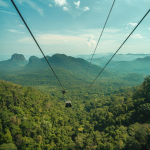Welcome to the ongoing saga of the Phu Kradueng cable car, an eco-narrative filled with twists and turns akin to the trails of the mountain it hopes to scale. Amid the lush landscapes of Loei, Thailand’s Natural Resources and Environment Minister Patcharawat Wongsuwan delivered news that stilled the hearts of aspiring visitors: the project has hit a red light over environmental concerns, as unveiled after a mobile cabinet session in scenic Nong Bua Lamphu.
Hinging on the cliff-edge of progress, the cabinet held back the waterfall of funds necessary to breathe life into a refreshed cable car design. This stands as a significant boulder in the path, for without a new blueprint, teams can’t embark on the necessary environmental impact assessment (EIA) adventures–a trek mandated by law. Adding complication, the map guiding the project, the original EIA, is older than a two-decade sun cycle.
General Patcharawat’s directives were clear as mountain spring water: consult the relevant agencies before such a request ascends. And so, Jatuporn Buruspat, the ministry’s permanent secretary, has been tasked with the vital liaison role. Shortly before these revelations, Puangpet Chunlaiad of the PM’s Office had an optimistic forecast: Loei’s eager authorities sought 28 million baht to kickstart the storied initiative.
Should the bureaucratic winds blow favorably, a completed EIA will sail towards the Ministry of Sports and Tourism’s harbor. There, the Designated Areas for Sustainable Tourism Administration (Dasta) will weigh in before the project circles back to the cabinet’s domain.
Ms. Puangpet’s ambition for the cable car stretches beyond her political tenure in Loei–seeing it soar would fill her heart with pride, offering tourists year-round access to Phu Kradueng’s breathtaking vistas. She envisions it as a beacon of progress, a project that has simmered in imagination for decades.
However, Deputy Prime Minister Phumtham Wechayachai reminds us that brainstorming is the flavor of the season. The environmental menu offers food for thought, and careful consideration must be the group’s chef de cuisine.
Currently, Attapol Charoenchansa, acting chief of the Department of National Parks, Wildlife, and Plant Conservation, has confirmed a greenlight for Dasta to survey the designated mountain trails, following the rules which offer a deadline come September 2025’s autumn embrace.
Yet, in response to the withheld funds, Dasta’s director Athikun Kongmee expressed an unruffled determination to complete and present the EIA for a natural and environmental planning office’s spring blessing the following year.
Amidst the administrative voices, echoes from the wild have arisen. Ornyupa Sangkamarn from the Seub Nakhasathien Foundation carries a message of caution, highlighting potential intrusions on the mountain’s biological tapestry due to increased human footprints.
In stark contrast, Sutham Thammachart, the local park shop association’s helmsman, advocates full steam ahead. The cable car symbolizes more than a mere ride; it’s a potential golden era for the province’s tourism narrative.
So, as Phu Kradueng’s peak stands undisturbed for now, the project lingers in a liminal space—a balance between innovation and preservation, economics and ecology. One can only wait for the day when the cable cars, possibly, grace the skies, or the forests steadfastly keep their ancient silence.


















Be First to Comment